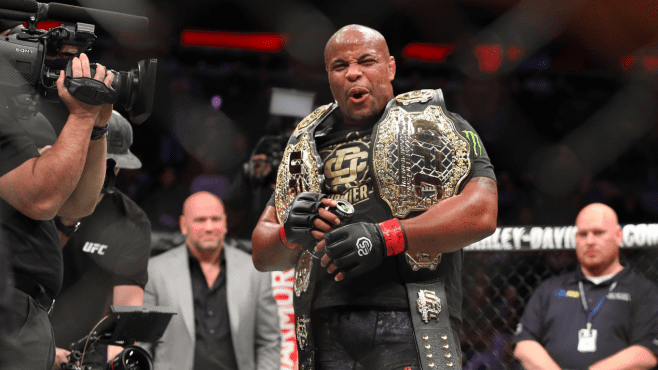
By JAKE MARTIN
Written for the LSWA
Don’t overthink it. Just wrestle.
That’s what UFC Hall of Famer Daniel Cormier tells his wrestling team at Gilroy High School in California. Rest assured, Cormier practiced what he now preaches. He wrestled most of his life, in fact, even in the face of great tragedy.
And though Cormier has wrestled more times than he can count, he wasn’t born a wrestler. He was born a fighter.
“Just fight.”
That was Cormier’s internal monologue after receiving the dreaded phone call back in 2011. Trying to dip his toe into the mixed martial arts pond after a remarkable run in his amateur wrestling career, Cormier served as an alternate in one of the most prestigious tournament brackets in MMA history. Everything changed when the UFC purchased Strikeforce, causing a domino effect that would shake up Strikeforce’s tournament lineup and force Cormier’s entry.
“I was hoping not to get into the tournament, man,” said Cormier, laughing.
His place in state sports history was noteworthy to that point; it soon became legendary, bringing global fame leading to his pending induction in the Louisiana Sports Hall of Fame. He is part of the 12-member Class of 2024 to be honored June 20-22 in Natchitoches. For participation opportunities, visit LaSportsHall.com or call 318-238-4255.
The Lafayette native, who started off as a relatively unknown in Strikeforce, couldn’t be found in the initial gambling futures for a tournament concept borrowed from the start-up days of the UFC and further popularized by PRIDE Fighting Championships in Japan years later.
Potentially serving as a crowning moment for one of several heavyweight legends occupying the bracket, the Strikeforce Heavyweight Grand Prix instead gave birth to a rising star. But Cormier had to walk through fire in a decision victory against Josh Barnett in the tournament finals on May 19, 2012, before being christened as MMA’s next big thing.
And that was unchartered territory. You see, in fights prior, the Olympic-level wrestler made the transition to MMA look darn near effortless. From knocking out Antonio “Bigfoot” Silva — a man that had a 10-inch reach advantage — to collecting a one-way traffic decision victory over Jeff Monson, Cormier often emerged victorious without a scratch. Fighting Barnett in the main event on Showtime established a launching pad for Cormier’s career, but he didn’t clear the bar unscathed. Call it baptism by fire.
“That was the first time I really took damage,” Cormier said. “Barnett was elbowing me, punching me, grinding his hand on my face. It was awful. I was so swollen after that fight. Bruised, cut on the top of my head. I walked into the hotel after the fight, and my friends were so excited. My hand is broken, my freaking head is busted open, but they didn’t care. ‘DC just won a belt!’ They want to go party in San Jose. They’re taking pictures, and I’m keeping it together. Then I see my mom, and I recall a story of when I was a young boy …”
Before Cormier became one of only four UFC fighters to hold championship belts from multiple weight classes simultaneously and one of the select few fighters to transition into a successful broadcaster, “D.C.” was a tough youngster playing backyard football with older neighborhood kids in the J. Wallace James Elementary School parking lot in Lafayette.
Back then, Cormier was running the football when a larger kid clotheslined him, knocking the future All-State football player to the ground and breaking his collarbone in the process. Unwilling to show weakness, Cormier fought back tears, walked home across the street and kept his composure until he saw his mother. All bets were off then.
“I walked into that hotel, at 33 years old, and when I saw my mother, I had the same reaction as I had when I was an 8-year-old boy. I bawled in her arms,” said Cormier. “I handed her the belt and I cried in her arms for 20 minutes because he hurt me. He hurt me a lot, and my comfort was always my mother.”
Life hits hard, but Cormier always punched back. But let’s be honest — sometimes he threw the first punch. Scrapping with friends in his neighborhood actually got him noticed by local wrestling coach Stephen “Tank” Lotief. Ironically, Cormier was in the same location he broke his collarbone when Lotief happened to stumble upon the future champion.
“One day on my way to practice at Northside High School, I saw him and two other kids playing football,” Lotief explained. “In the middle of the school parking lot, I’m watching them as I drive by and one of them tackled another and they started fighting. Of course, I pull over and I’m like, ‘Hey! Hey! Cut that out!’ I asked them if they wanted to come out and join my wrestling team. I often think about, ‘What would have happened if I didn’t stop the car?’”
Cormier accepted the invitation fully prepared to swing a metal chair like one of his heroes on television.
“I thought I would be doing some WCW stuff, man, like Ric Flair and Lex Luger,” Cormier said, grinning. “But I liked it. I stuck with it.”
Success followed. With a 101-9 overall record at Northside High and three consecutive state titles, local newspaper clippings in the late ‘90s dubbed it a “moral victory” for his opponents to avoid being pinned.
While winning a bronze medal in the World Championships in the Greco-Roman Wrestling Cadet (15-16 years old) division, Cormier also gained recognition on the football field.
He chose to concentrate on wrestling upon graduation, though, and accumulated a 61-0 record at Colby (Kansas) Community College before becoming an All-American at Oklahoma State. That’s where Cormier met fellow wrestler Jamill Kelly. Cormier and Kelly naturally gravitated toward each other because, as Kelly bluntly put it, there weren’t many African Americans competing in the sport. Following their college careers, Cormier and Kelly pursued international wrestling goals. They forged a tight bond that would become unbreakable when Cormier received a life-changing phone call.
“I can literally visualize it today,” Kelly said. “We were young. I was like 23 or 24 at the time, and he gets a phone call that his little girl passed away. What do you say? What do you do? I didn’t know what to say or do but to just hug him and sit there in shock with him.”
Cormier’s three-month-old daughter, Kaedyn, tragically died in an automobile accident in 2003, and where there was great sadness, a greater purpose was also formed.
“When you get a call like that, you don’t know what to make of that information,” Cormier said. “As time went on, I used it as a tool to propel myself forward and do things the right way. I competed for my daughter. I had an angel in the octagon. I came out of this thing relatively clean. I have all my faculties up top. I’m not that beat up. I’m lucky. I believe Kaedyn always guided me in everything I did. I think about her all the time.”
After falling short in the 2008 Summer Olympics, Cormier decided to give fighting a shot. He connected with Bob Cook in California, where he would later become one of the “Four Kings” of AKA with UFC champions Cain Velasquez, Khabib Nurmagomedov and Luke Rockhold.
Though his 22-3 fighting record might suggest otherwise, nothing came easy for Cormier, at least not in the gym. Upon arrival, AKA coaches had him spar Velasquez in a sink-or-swim scenario.
“I will never in my life of fighting credit anyone more than Cain,” Cormier said. “I would have never fought (Velasquez). The money didn’t affect who I am because I knew I owed Cain far too much. When I signed with the UFC from Strikeforce, they told me I have to do something because Cain and I were too good not to fight each other. So I said, ‘Fine, I’ll go down to 205 (pounds).’ I’ll never do anything to hurt him or his family. I love the guy too much.”
From earning the title “double champ” by knocking out heavyweight great Stipe Miocic in 2018 to headlining against bitter rival Jon Jones on multiple occasions, Cormier earned all-time great status.
USA Today’s MMA Junkie ranked Cormier as the seventh best fighter in UFC history in 2023. His résumé includes the third-most victories in light heavyweight history and 10th most wins in heavyweight history, but the moments were arguably just as big as his achievements. His last 11 fights were scheduled championship fights with a short-notice non-title fight against legend Anderson Silva at UFC 200 being the one exception. That resulted from Jones pulling out of the UFC 200 main event.
Embodying the first UFC slogan, “as real as it gets,” Cormier’s rivalry with Jones was a profitable one for the UFC. According to Tapology, Cormier vs. Jones II at UFC 214 garnered 860,000 PPV buys.
“There will never be anything like it because it was real,” said Cormier, who lost to Jones twice before the rematch was overturned to a no-contest when Jones tested positive for the anabolic steroid Turinabol. “I believe it was the best rivalry. It was the two best fighters fighting in a real rivalry. I always appreciated him for the business. We were business partners, and we did good business together. My stance on him has softened since I’m no longer competing, but it’s not like we’ll go off and have a Saturday afternoon barbeque together.”
Wrestling was always the bedrock. Fighting functioned as the building blocks that made Cormier visible to mainstream combat sports fans all over the world. It was the natural evolution for a young boy throwing punches in a parking lot. But the foundation would have collapsed without the work ethic instilled by his late parents. Without it, Cormier’s days on the mat would have been numbered. When others stopped attending Lotief’s wrestling practices, Cormier became a fixture in that hot room. And now it’s his turn to mold a new generation of wrestlers.
“I’m a kid from Lafayette, Louisiana, that didn’t come from much. No one could have thought that we would go on this journey. My mom and my dad never flew on an airplane until I made my first world team,” Cormier said. “They sacrificed so much for me. They’re both gone today, but these people showed me what life was supposed to be. To be entering the Louisiana Sports Hall of Fame means the world to me. I know to get recognition here; you had to have done something truly special because Louisiana sports matter. My son was going crazy when he heard it because my kids know. They know what sports mean here.”
Jake Martin, a member of the Louisiana Sports Hall of Fame selection committee, is a multiple-time LSWA award winner as the sports editor of the Ouachita Citizen.

